Remembering Sir Arthur C. Clarke, visionary of global satellite communications
16 April 2008
News
Information from ITU
Science fiction writer and visionary Sir Arthur C. Clarke died on 19 March 2008 in Colombo, Sri Lanka, at the age of 90. He was born on 16 December 1917 in Minehead, Somerset in the United Kingdom and moved to Sri Lanka – then called Ceylon, in 1956.
Sir Arthur C. Clarke
The international telecommunication community will remember Sir Arthur for making popular the concept of using the geostationary orbit for communications. In October 1945, Clarke published in the British magazine Wireless World a technical paper entitled ‘Extra-terrestrial Relays — Can Rocket Stations Give World-wide Radio Coverage?’ The paper established the feasibility of artificial satellites as relay stations for Earth-based communications. Clarke predicted that one day communications around the world would be possible via a network of three geostationary satellites spaced at equal intervals around the Earth’s equator.
Nearly two decades later, in 1964, Syncom 3 became the first geostationary satellite to finally fulfil Clarke’s prediction. Later that year, Syncom 3 was used to relay television coverage of the Summer Olympic Games in Tokyo to the United States — the first television transmission over the Pacific Ocean. Now, there are hundreds of satellites in orbit and providing communications to millions of people around the globe. In 1954, Clarke had also proposed using satellites in meteorology. Today, we cannot imagine predicting the weather without using dedicated meteorological satellites.
Looking back on these developments, in his book ‘How the World Was One — Beyond the Global Village’, published in 1992, Clarke wrote: “Sometimes I am afraid that you people down on Earth take the space stations for granted, forgetting the skill and science and courage that went into making them. How often do you stop to think that all your long-distance phone calls – and most of your TV programmes – are routed through one or more satellites? And how often do you give any credit to the meteorologists for the fact that weather forecasts are no longer the joke they were to our grandfathers, but are dead accurate 99% of the time?” Apparently the meteorological systems he refers to are more advanced than those employed in South Africa.
Valery Timofeev, Director of the ITU (International Telecommunication Union) Radiocommunication Bureau, who met Clarke in 1979 at an INTELSAT Exhibition, remembers him “as an extraordinary man of great warmth and scientific vision, who devoted all his writings and predictions to the positive development of humankind”.
Further reading:
Electronic News Digest
News
A brief synopsis of current global news relating to the electronic engineering fields with regards to company finances, general company news, and engineering technologies.
Read more...
4000 A containerised DB for power project
News
Power Process Systems has successfully completed the design, fabrication, and commissioning of a 4000 A containerised distribution board for a wind/PV solar hybrid renewable energy project.
Read more...
Datacentrix Industrial Indaba 2025
News
Datacentrix recently hosted its inaugural Industrial Indaba 2025, where industry leaders explored how digitalisation, resilience, security and compliance are shaping the future of sustainable industrial operations in Africa.
Read more...
RS brings solar light to 150 000 people
RS South Africa
News
The company’s three-year partnership with SolarAid aims to raise £1 million through corporate donations, matched funding, product contributions, and fundraising to accelerate access to safe, sustainable energy.
Read more...
Microchip and AVIVA Links collaboration
Altron Arrow
News
Microchip and AVIVA Links have achieved groundbreaking ASA-ML interoperability, accelerating the shift to open standards for automotive connectivity.
Read more...
World’s leading supplier of grid automation products
News
Hitachi Energy was recognised as the global market share leader in grid automation for electric power transmission and distribution utilities by ARC Advisory Group.
Read more...
Vivashan Muthan appointed as head of export sales and operations at RS South Africa
RS South Africa
News
With a career spanning engineering, business development, and sales leadership across sub-Saharan Africa, Vivashan Muthan brings a wealth of expertise to his new role as head of export sales and operations.
Read more...
Google equips university students across Africa with free access to advanced AI tools
News
A 12-month Google AI Pro plan has been launched for students in Ghana, Kenya, Nigeria, Rwanda, South Africa, and Zimbabwe to build foundational AI skills.
Read more...
Africa’s space economy projected to be worth $22,6 billion in 2026
News
South Africa is gearing up to be at the forefront of the growth in the space industry, creating thousands of jobs, driving innovation, and boosting the national economy.
Read more...
Distribution partnership with MacDermid Alpha
Testerion
News
MacDermid Alpha Electronics Solutions India Private Limited has announced that as of 01 September 2025 Testerion will be the sole importer and distributor of their products to the South African market.
Read more...


